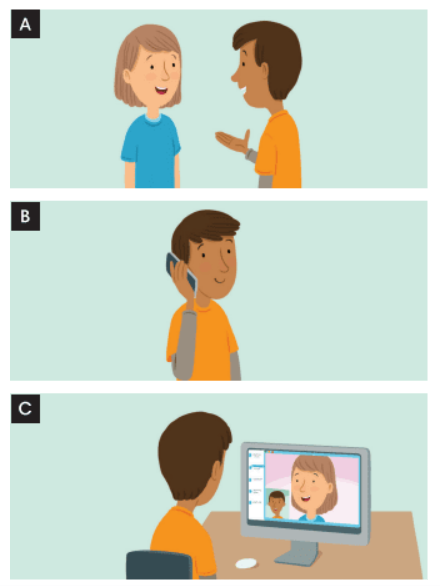Fill in the blanks with only one word.
A long time ago, robots belonged to science fiction. Children loved
at movies with robots. Today, robots are real, and they are helping us. In the
, we will all have robots. They will vacuum the floor, wash the
dishes, perhaps even drive our cars. I even think one day we’ll have robot
. In Japan today, robot engineers are making robots to help old
people and to keep them company. It’s still early days. I’d say we are
another 20 to 30 years away from robots being
in our lives.
What will happen to us when the world is full of robots? There’ll be no jobs.
McDonalds will be full of smiling robots. Maybe one day we won’t be able
to tell robots and
apart. Maybe they’ll take over the world.
A long time ago, robots belonged to science fiction. Children loved
at movies with robots. Today, robots are real, and they are helping us. In the
, we will all have robots. They will vacuum the floor, wash the
dishes, perhaps even drive our cars. I even think one day we’ll have robot
. In Japan today, robot engineers are making robots to help old
people and to keep them company. It’s still early days. I’d say we are
another 20 to 30 years away from robots being
in our lives.
What will happen to us when the world is full of robots? There’ll be no jobs.
McDonalds will be full of smiling robots. Maybe one day we won’t be able
to tell robots and
apart. Maybe they’ll take over the world.
Kiến thức: nghe hiểu và nắm bắt từ khóa
A long time ago, robots belonged to science fiction. Children loved (1) looking at movies with robots. Today, robots are real, and they are helping us. In the (2) future, we will all have robots. They will vacuum the floor, wash the dishes, perhaps even drive our cars. I even think one day we’ll have robot (3) friends. In Japan today, robot engineers are making robots to help old people and to keep them company. It’s still early days. I’d say we are another 20 to 30 years away from robots being (4) everywhere in our lives. What will happen to us when the world is full of robots? There’ll be no jobs. McDonalds will be full of smiling robots. Maybe one day we won’t be able to tell robots and (5) humans apart. Maybe they’ll take over the world.
Tạm dịch:
Cách đây rất lâu, robot thuộc về khoa học viễn tưởng. Trẻ em thích xem phim với robot. Ngày nay, robot là có thật, và chúng đang giúp chúng ta. Trong tương lai, tất cả chúng ta sẽ có robot. Họ sẽ hút bụi sàn nhà, rửa bát, thậm chí có thể lái xe của chúng tôi. Tôi thậm chí nghĩ rằng một ngày nào đó chúng ta sẽ có những người bạn robot. Ở Nhật Bản ngày nay, các kỹ sư rô bốt đang chế tạo rô bốt để giúp đỡ những người già và để luôn đồng hành Đó vẫn còn là những bước đầu. Tôi muốn nói rằng chúng ta còn 20 đến 30 năm nữa để robot có mặt ở mọi nơi trong cuộc sống của chúng ta. Điều gì sẽ xảy ra với chúng ta khi thế giới chỉ toàn robot? Sẽ không có việc làm. McDonalds sẽ có đầy những robot luôn tươi cười. Có lẽ một ngày nào đó chúng ta sẽ không thể phân biệt được robot và con người. Có thể chúng sẽ tiếp quản thế giới.

Các bài tập cùng chuyên đề
3. Listen to the radio programme from 4Teen News. Then fill the blanks with the words you hear.
(Nghe chương trình radio từ 4Teen News. Sau đó điền những từ bạn nghe được vào chỗ trống.)
Speaker: Today we asked our friends: Tom from Australia, Linh from Viet Nam and Nobita from Japan to tell us about their robots. Tom, would you like to start?
Tom: Well my robot can (1) __________ what i say. It can also understand my feelings. It's the (2) __________ robot
Speaker: Linh?
Linh: My robot is my best friend. It does a lot for me: clean the floor, (3) __________ my toys away, and
Speaker: And Nobita?
Nobita: My robot is very useful. It helps me a lot. It can (4) __________ my plants and even work as a (5) __________
Listening
1. Listen to the conversation between Khang and Dr Adams and tick the phrases you hear.
(Hãy nghe đoạn hội thoại giữa Khang và Dr Adams và đánh dấu vào những cụm từ bạn nghe được.)
|
look after sick people (chăm sóc người ốm) |
|
|
understand what we say (hiểu những gì chúng tôi nói) |
|
|
build the very high buildings (xây dựng những tòa nhà rất cao) |
|
|
teach many subjects (dạy nhiều môn học) |
|
|
move heavy things (di chuyển những thứ nặng) |
|
2. Listen to the conversation again and tick (✓ ) T (True) or F (False).
(Nghe lại đoạn hội thoại và đánh dấu (✓ ) T (Đúng) hoặc F (Sai).)
|
|
T |
F |
|
1. Robots can't do many things today. |
|
|
|
2. Worker robots can build very high buildings. |
|
|
|
3. Teacher robots can teach on the internet. |
|
|
|
4. Robots can talk to humans. |
|
|
|
5. Robots can do everything like humans. |
|
|
1. In pairs, look at the picture above. What’s strange about it? Read the comments and check.
(Theo cặp, các em hãy nhìn bức ảnh trên và nói xem có gì bất thường? Đọc các bình luận và kiểm tra đáp án của mình.)
2. Listen and match the speaker (1-3) with the questions they are answering (a-f). There are two questions for each speaker.
(Nghe và ghép người nói (1-3) với những câu hỏi mà họ đang trả lời (a-f). Có hai câu hỏi cho từng người nói.)
a. Who was your idol when you were seven or eight?
b. Did you have a favourite singer or group when you were little?
c. Which cartoons did you like?
d. What was your first phone like?
e. What toys did you like best?
f. Do you remember any fashion from when you were younger?
3. Listen again and write down the speakers’ answers to the question in Exercise 2.
(Nghe lại lần nữa và viết câu trả lời của người nói trong bài tập 2)
2. Listen to Part 2 of the conversation above. Tick the things Max and Eva do with their smartphone.
(Nghe đoạn hội thoại 2. Đánh dấu vào những thứ mà Max và Eva đã làm với điện thoại của họ.)
1. _______ phone the police
2. _______ phone for an ambulance
3. _______ take a selfie with a police officer
4. _______ take a photo of the car
5. _______ check where they are on a map
3. Listen to an interview. Match the speakers (1-4) with the questions they are answering (a-h).
(Nghe một cuộc phỏng vấn. Nối người nói (1-4) với câu hỏi họ đang trả lời (a-h).)
|
1. Beth 2. Becky 3. Charlie 4. Lisa |
a. Where did you meet your first best friend? b. Did you live near him or her? c. Were your hobbies and interests the same? d. Did you like the same music? e. What toys did you like? f. Did you like the same food? g. Did you dress in a similar way? h. Is he or she still your best friend today? |
4. Listen again. Choose the correct option.
(Nghe lại. Chọn phương án đúng.)
1. Beth and Eva met at primary / secondary school.
2. They had the same / different interests.
3. Gwen and Becky are no longer / still friends.
4. They liked / didn't like the same music.
5. Ben and Charlie lived / didn't live next to each other.
6. They wore different / similar clothes.
7. Lisa and Tina liked boys'/ girls' toys.
8. They liked the same / different food.
3. Listen. What sort of conversation are Beth and Lenny having? Choose the correct answer.
(Nghe. Beth và Lenny đang trò chuyện kiểu gì? Chọn câu trả lời đúng.)

4. Listen again. Choose the correct answer.
(Nghe một lần nữa. Chọn câu trả lời đúng.)
1. At the moment Beth is
a. in her room.
b. in another room in her house.
c. in the garden.
2. Beth is there because
a. her computer is rubbish.
b. her brother's room is nicer.
c. there's bad wi-fi signal in other rooms.
3. For his birthday Lenny got a new
a. tablet.
b. camera.
c. smartphone.
4. Owen wants to
a. go to bed.
b. look at some pictures.
c. play some music.
5. Lenny agrees to
a. call Beth back.
b. give Owen some help.
c. help Beth with her guitar lesson.







